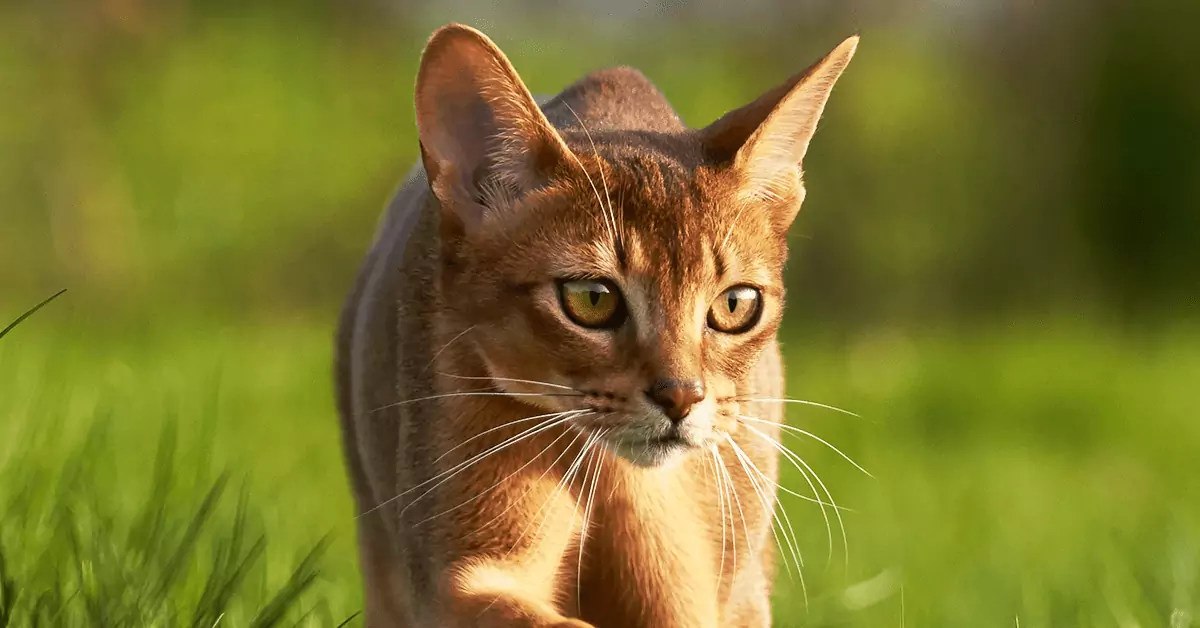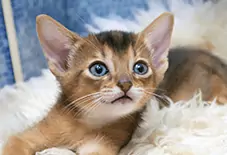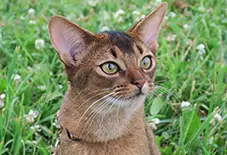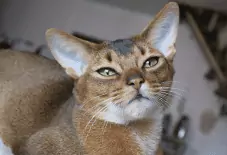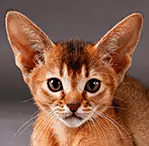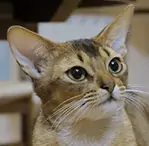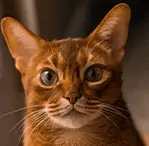
Prrrfect Playmate

High Kitty I.Q.

Family-Friendly Feline
Looking for an intelligent kitty who doubles as the prrrfect playmate? Then I’m the pawfect cat fur you! I LOVE to play – seriously, it’s all I do. When I’m not running, jumping, or playing (which is almost never), I like to cuddle up with my people on the couch, like any good lap cat. I’m also a family feline, so I’m gr
eat with kids, other cats, and even
dogs. And I love my
humans, so I’d prefer to live inside the house, if that’s alright with you. But despite my constant need to entertain, I’m pretty low-maintenance. You can easily maintain my beautiful ticked coat with regular
brushing, and I don’t really shed. I’m prone to some health issues, though, so pawlease make sure I have a good vet for the best cat care. I’m a quiet kitty, but what I lack for in volume, I make up for in playfulness. You’ll never be bored when I’m around!
关于我
Personality
Playful
Intelligent
Loving
Length Range
12-16 Inches (not including tail)
Coat Details
Type
Short-Medium
Texture
Silky
Colors
Ruddy, Red, Blue, Cinnamon, Fawn
Pattern
Ticked

My Many Looks

My Breed Characteristics

Furbulous Fact
An Abysinnian starred in the 1978 Disney movie The Cat From Outer Space. The movie follows Jake, an Abyssinian cat from another planet, as he tries to rebuild his spaceship after crash-landing on Earth. Wondering if Jake ever makes it back home? Guess you’ll have to watch the movie to find out!

As I Grow Up
As you can see, we Abyssinians age pretty gracefully. Here are a few key milestones in my growth & development to be aware of as I grow up from a kitten to an adult and senior!

History of My Breed
My breed’s history is a little fuzzy, but the first written record of us dates back to the 19th century, during England’s Victorian Era. Cat shows were extremely pawpular and it was at one of these – the Crystal Palace Cat Show – that we Abyssinians made our debut! We even won third place! Back then, most humans believed that British soldiers had brought us back from Abyssinia, or modern day Ethiopia, after the Abyssinian War. But this was just speculation. Other humans thought that we hailed from ancient Egypt, and some went so far as to claim the Pharaohs had loved us. had it that we hailed None of this was true, but can you blame the humans for thinking it was? We do look very similar to the cats depicted in ancient Egyptian art! Just look at our large ears!) How do we know these rumors aren’t true? Well, the oldest taxidermied Abyssinian isn’t in Ethiopia or Egypt – it’s in a museum in Holland. The Leiden Zoological Museum purchased the Abyssinian sometime between 1834 and 1836, and the founder of the museum labeled it “Patrie, domestica India,” linking our homeland to Asia. Genetic testing eventually confirmed that we originated by the Indian Ocean, where English colonists may have picked us up during a stop in Calcutta, which was then an East India Company trading post. Nowadays, the humans think our ancestors are the Burmese, Siamese, and Russian Blue cats. Though we first arrived in the United States in the early 1900s, it wasn’t until the 1930s that an Abyssinian breeding program really took off. We have lots of nicknames – one of them being Aby Grabby,because we love to play with objects around the house! In 1934, we were registered by the Cat Fanciers Association. Since then, we’ve become one of the most popular purebred cats!

Care Tips
from Dr. Jessica Greenberg, Associate Veterinarian
1
Watch your Abyssinian’s weight.
Like many cat breeds, Abyssinians are prone to obesity, and their delicate frame actually makes them even more likely to become obese. Make sure you’re feeding your Abyssinian high-quality cat food and be mindful of the amount of treats you’re giving them.
2
Look out for signs of heart disease.
Many purebred cats have an increased risk of heart disease, including Abyssinians. Watch for lethargy, changes in behavior, and difficulty breathing and talk to your vet right away if you see any of these signs.
3
Know the signs of FIP.
Purebred cats are more likely to develop FIP (Feline Infectious Peritonitis), which is a feline coronavirus that impacts both wild and domestic cats. Alert your vet to any behavior changes or signs of illness, such as bloated stomach, cloudy eyes, or general lethargy.

Training Tips
from Dr. Jessica Greenberg, Associate Veterinarian
